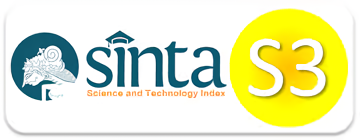EVALUATION ANALYSIS OF AIRLANGGA UNIVERSITY FACULTY OF VOCATIONAL EDUCATION'S BRAND EQUITY USING CUSTOMER BASED BRAND EQUITY CONCEPT
Downloads
Indonesia is now facing a new order of global world in terms of economics, educations and other infrastructures. Therefore, Government focus on developing an education system which is not only based on academic and professional fields but also vocational fields during the last decade. Brand is the identity of a product that can be used as a measurement of its quality. The concept is customer based brand equity (CBBE) which will be adopted in this study.
This study aims to determine the strength of Airlangga University Faculty of Vocational Education Education's brand equity.
This study is using descriptive quantitative research approach. It describes the consumer assessment. In this case is the brand equity stakeholder's institution Airlangga University Faculty of Vocational Education.
These results indicate that brand awareness of this institution's stakeholder is good. Based on the data, more than 60 respondents from a total of 77 respondents has already knew the existence of Airlangga University Faculty of Vocational Education. In addition, Stakeholders Faculty of Vocational Education already have brand loyalty to their institution. Therefore, they are willing to promote and give more contributions to Airlangga University Faculty of Vocational Education in order to become a better faculty. Airlangga University Faculty of Vocational Education has a strong brand image in the perception of their stakeholders. Concerning that the Faculty of Vocational Education is an applied science faculty, this institution consists of the entire course both Diploma III and Diploma IV at Airlangga University. Last, Stakeholders have a good perception related with the quality of Airlangga University Faculty of Vocational Education in order to create graduates or alumnae which is ready to work.
The conclusion of this study is the strength of Airlangga University Faculty of Vocational Education's brand equity in the perception of their stakeholders are good in fact. Airlangga University Faculty of Vocational Education has a strong image as a faculty of applied science which consists of the entire course both Diploma III and Diploma IV at Airlangga University.
Keywords: Brand Equity, Customer Based Brand Equity, Faculty of Vocational Education Education, Airlangga University
_____. 2016. Power Marketing.Jakarta : Jakarta Consulting Group. Retrieved from http://www.jakartaconsulting.com/publications/articles/bizmark/power-marketing-2.
_____. 2015. Panduan Pendidikan Fakultas Vokasi Universitas Airlangga. Surabaya : Airlangga University Press.
_____. 2012. Undang-Undang Republik Indonesia Nomor 12 Tentang Pendidikan Tinggi. Retrieved from risbang.ristekdikti.go.id/regulasi/uu-12-2012.pdf
Aaker. (1996). Building Strong Brands. New York: Free Press.
Aaker, A. David., 1997. Manajemen Ekuitas Merek. Jakarta: Mitra Utama
Andriani, N.,&Sembiring,B.K.F. (2013). Analisis Strategi Merek Dan Citra Merek Terhadap Keputusan Pembelian Pada J.Co Donuts & Coffee Cabang Cambridge City Square Medan. Jurnal Media Informasi Manajemen.
Arafat, Wilson. 2006. Behind a Powerful Image: Menggenggam Strategi dan Kunci-kunci Sukses Menancapkan Image Perusahaan yang Kokoh.Yogyakarta: Andi
Christoper Lovelock.2005. Manajemen Pemasaran Jasa, Kelompok Gramedia, Indeks, Indonesia
Daft, Richard L. 2002. Manajemen Edisi Kelima Jilid Satu. Jakarta : Erlangga.
Guzmán, F. (2012). Consumer Perception of Brand Equity Measurement: A New Scale (Doctoral Dissertation), University of North Texas).
Hawkins, D.I., dan Mothersbaugh, D.L. (2010). Consumer Behavior: Building Marketing Strategy.11th edition. McGraw-Hill, Irwin.
Indriantoro, Nur., Supomo, Bambang. 2002. Metedologi Penelitian Bisnis Edisi Pertama.Yogyakarta:, Penerbit BPFE.
Kevin Lane Keller. 2003. Strategic Brand Manajemen. Prentice Hall:Second Edition
Kotler,P.,&Amstrong,G. 2004. Principles of Marketing 10th Edition. New Jersey: Pearson Prentice Hall. Retrieved from https://www.abebooks.com/Principles-Marketing-10th-Edition-Kotler-Philip/884816074/bd
Kotler, Philip and Gary Armstrong. 2008. Prinsip-prinsip Pemasaran. Edisi12. Jilid 1. Jakarta: Erlangga.
Kuncoro, Mudrajad. 2009. Metode Riset Untuk Bisnis dan Ekonomi. Jakarta : Erlangga
Kusmayadi dan Sugiarto, Endar. 2000, Metode Penelitian dalam Bidang Kepariwisataan,Jakarta: PT Gramedia Pusataka Utama.
Lukman, D.M., (2014). Analisis Pengaruh Ekuitas Merek Terhadap Keputusan Pembelian dan Kepuasan Konsumen Produk Teh Botol Sosro Kemasan Kotak. Jurnal Administrasi Bisnis, Vol.10, No.1: hal. 64–81
Permadi, P.C.,Kumadji,S.,&Kusumawati, A. (2014). Pengaruh Citra Merek Terhadap Word Of Mouth Dan Keputusan Pembelian (Survei Pada Konsumen Dapoer Mie Galau Jalan Selorejo 83 Malang). Jurnal Administrasi Bisnis Vol 10 No 1.
Radji, D. L. Citra Merek Perusahaan Dan Loyalitas Konsumen (Sebuah Kajian Teoritis). Retrieved from http://scholar.googleusercontent.com/scholar?q=cache:1LR8z2C fvIJ:scholar.google.com/&hl=en&as_sdt=0,5
Schiffman dan Kanuk. 2010. Perilaku Konsumen. Jakarta: PT. INDEK.
Sugiyono.(2007).Metode Penelitian pedidikan pendekatan kuantitatif, kualitatif, dan R&D.Bandung: Alfabeta
Sugiyono, 2008, Metode Penelitian Bisnis. Bandung:Alfabeta
Sugiyono.(2010). MetodePenelitianKuantitatif Kualitatif & RND. Bandung : Alfabeta
Sukaatmaja, I.P.G. (2012). Analisis Ekuitas Merek Produk Waterbased Finising Izykote (Kasus Di Kabupaten Gianyar). Jurnal Manajemen, Strategi Bisnis, dan Kewirausahaan Vol. 6, 151 No. 2.
Tjiptono,Fandy. 2005. Pemasaran Jasa.Malang: Bayumedia Publishing.
Widjadja, M., Wijaya, S.,&Jokom,R., (2008). Analisis Penilaian Konsumen Terhadap Ekuitas Merek Coffee Shops Di Surabaya. Jurnal Manajemen Perhotelan.
Widarto. (2009). Model Pendidikan Vokasi Yang Efektif dan Efisien. Retrieved from staff.uny.ac.id/sites/.../Dr..../Model%20Pendidikan%20Vokasi.pdf
Copyright notice:
- Authors retain copyright and grant the journal right of first publication with the work simultaneously licensed under a Creative Commons Attribution-NonCommercial-ShareAlike 4.0 International License that allows others to share the work with an acknowledgement of the work's authorship and initial publication in this journal.
- Authors are able to enter into separate, additional contractual arrangements for the non-exclusive distribution of the journal's published version of the work with an acknowledgement of its initial publication in this journal.
- Authors are permitted and encouraged to post their work online (e.g., in institutional repositories or on their website) prior to and during the submission process, as it can lead to productive exchanges, as well as earlier and greater citation of published work (See The Effect of Open Access)
















